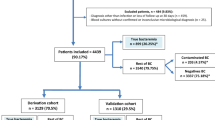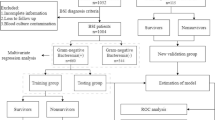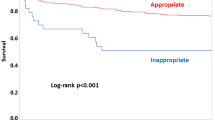Abstract
Introduction
Bacteremia is a major cause of morbidity and mortality in hospitalized patients. Predictors of mortality are critical for the management and survival of hospitalized patients. The objective of this study was to determine the factors related to blood culture positivity and the risk factors for mortality in patients whose blood cultures were collected.
Methods
A prospective 2-cohort study (derivation with 784 patients and validation with 380 patients) based on the Pitt bacteremia score for all patients undergoing blood culture collection. The score was obtained from multivariate analysis. The Kaplan–Meier survival curve of the cohort derivation and the cohort validation groups was calculated, and the difference was assessed using a log-rank test. Mortality-related factors were older age, extended hospitalization, > 10% of immature cells in the leukogram, lower mean blood pressure, elevated heart rate, elevated WBC count, and elevated respiratory rate. These continuous variables were dichotomized according to their significance level, and a cut-off limit was created.
Results
The area under the ROC curve (AUC) was 0.789. The score was validated in a group of 380 patients who were prospectively evaluated.
Conclusion
Prolonged hospitalization, body temperature, and elevated heart rate were related to positive blood cultures. The Pitt score can be used to assess the risk of death; however it can be individualized according to the epidemiology of each hospital.


Similar content being viewed by others
Data availability
Data are available on demand.
Change history
16 January 2022
ORCiD for Dr. Raquel Zanella Bertoldo was removed.
References
Brooks D, Smith A, Young D, Fulton R, Booth MG (2016) Mortality in intensive care: the impact of bacteremia and the utility of systemic inflammatory response syndrome. Am J Infect Control 44(11):1291–1295
Knaus WA, Draper EA, Wagner DP, Zimmerman JE (1985) APACHE II: a severity of disease classification system. Crit Care Med 13(10):818–829
Hilf M, Yu VL, Sharp J, Zuravleff JJ, Korvick JA, Muder RR (1989) Antibiotic therapy for Pseudomonas aeruginosa bacteremia: outcome correlations in a prospective study of 200 patients. Am J Med 87(5):540–546
Gutierrez-Gutierrez B, Salamanca E, de Cueto M, Hsueh PR, Viale P, Pano-Pardo JR et al (2016) A predictive model of mortality in patients with bloodstream infections due to carbapenemase-producing enterobacteriaceae. Mayo Clin Proc 91(10):1362–1371
Rhee JY, Kwon KT, Ki HK, Shin SY, Jung DS, Chung DR et al (2009) Scoring systems for prediction of mortality in patients with intensive care unit-acquired sepsis: a comparison of the Pitt bacteremia score and the acute physiology and chronic health evaluation iI scoring systems. Shock 31(2):146–150
Martinez RM, Wolk DM (2016) Bloodstream infections. Microbiol Spectr 4(4):1–34
Kumar A, Roberts D, Wood KE, Light B, Parrillo JE, Sharma S et al (2006) Duration of hypotension before initiation of effective antimicrobial therapy is the critical determinant of survival in human septic shock. Crit Care Med 34(6):1589–1596
Chow JW, Fine MJ, Shlaes DM, Quinn JP, Hooper DC, Johnson MP et al (1991) Enterobacter bacteremia: clinical features and emergence of antibiotic resistance during therapy. Ann Intern Med 115(8):585–590
Chow JW, Yu VL (1999) Combination antibiotic therapy versus monotherapy for gram-negative bacteraemia: a commentary. Int J Antimicrob Agents 11(1):7–12
Forsblom E, Aittoniemi J, Ruotsalainen E, Helmijoki V, Huttunen R, Jylhava J et al (2014) High cell-free DNA predicts fatal outcome among Staphylococcus aureus bacteraemia patients with intensive care unit treatment. PLoS One. 9(2):e87741
Henderson H, Luterbach CL, Cober E, Richter SS, Salata RA, Kalayjian RC et al (2020) The Pitt bacteremia score predicts mortality in non-bacteremic infections. Clin Infect Dis. 70(9):1826–1833
Silva CS, Sena KX, Chiapetta AA, Queiroz MM, VIlar MC, Coutinho HM (2006) Incidência Bacteriana em Hemoculturas. NewsLab 77:12
Martin GS, Mannino DM, Eaton S, Moss M (2003) The epidemiology of sepsis in the United States from 1979 through 2000. N Engl J Med 348(16):1546–1554
Buetti N, Marschall J, Atkinson A, Kronenberg A, Swiss Centre for Antibiotic R (2016) National bloodstream infection surveillance in Switzerland 2008–2014: different patterns and trends for university and community hospitals. Infect Control Hosp Epidemiol 37(9):1060–7
Wasihun AG, Wlekidan LN, Gebremariam SA, Dejene TA, Welderufael AL, Haile TD et al (2015) Bacteriological profile and antimicrobial susceptibility patterns of blood culture isolates among febrile patients in Mekelle Hospital. Northern Ethiopia Springerplus 4:314
Haimi-Cohen Y, Shafinoori S, Tucci V, Rubin LG (2003) Use of incubation time to detection in BACTEC 9240 to distinguish coagulase-negative staphylococcal contamination from infection in pediatric blood cultures. Pediatr Infect Dis J 22(11):968–974
Liberati A, D’Amico R, Pifferi S, Torri V, Brazzi L, Parmelli E (2009) Antibiotic prophylaxis to reduce respiratory tract infections and mortality in adults receiving intensive care. Cochrane Database Syst Rev. 4:CD000022
Lawrence KL, Kollef MH (2009) Antimicrobial stewardship in the intensive care unit: advances and obstacles. Am J Respir Crit Care Med 179(6):434–438
Schermer CR, Sanchez DP, Qualls CR, Demarest GB, Albrecht RM, Fry DE (2002) Blood culturing practices in a trauma intensive care unit: does concurrent antibiotic use make a difference? J Trauma 52(3):463–468
Previsdomini M, Gini M, Cerutti B, Dolina M, Perren A (2012) Predictors of positive blood cultures in critically ill patients: a retrospective evaluation. Croat Med J 53(1):30–39
Sogaard M, Schonheyder HC, Riis A, Sorensen HT, Norgaard M (2008) Short-term mortality in relation to age and comorbidity in older adults with community-acquired bacteremia: a population-based cohort study. J Am Geriatr Soc 56(9):1593–1600
Author information
Authors and Affiliations
Contributions
FFT, conceptualization and final review; JPT, data analysis and draft manuscript; MBB, data evaluation and draft; RZB, data evaluation and draft; JC, database organization and analysis; VTR, draft review.
Corresponding author
Ethics declarations
Ethics approval
This study was approved by the local ethical committee.
Conflict of interest
The authors declare no competing interests.
Additional information
Responsible Editor: Afonso Luis Barth
Publisher’s note
Springer Nature remains neutral with regard to jurisdictional claims in published maps and institutional affiliations.
Rights and permissions
About this article
Cite this article
Tuon, F.F., Telles, J.P., Cieslinski, J. et al. Development and validation of a risk score for predicting positivity of blood cultures and mortality in patients with bacteremia and fungemia. Braz J Microbiol 52, 1865–1871 (2021). https://doi.org/10.1007/s42770-021-00581-5
Received:
Accepted:
Published:
Issue Date:
DOI: https://doi.org/10.1007/s42770-021-00581-5




